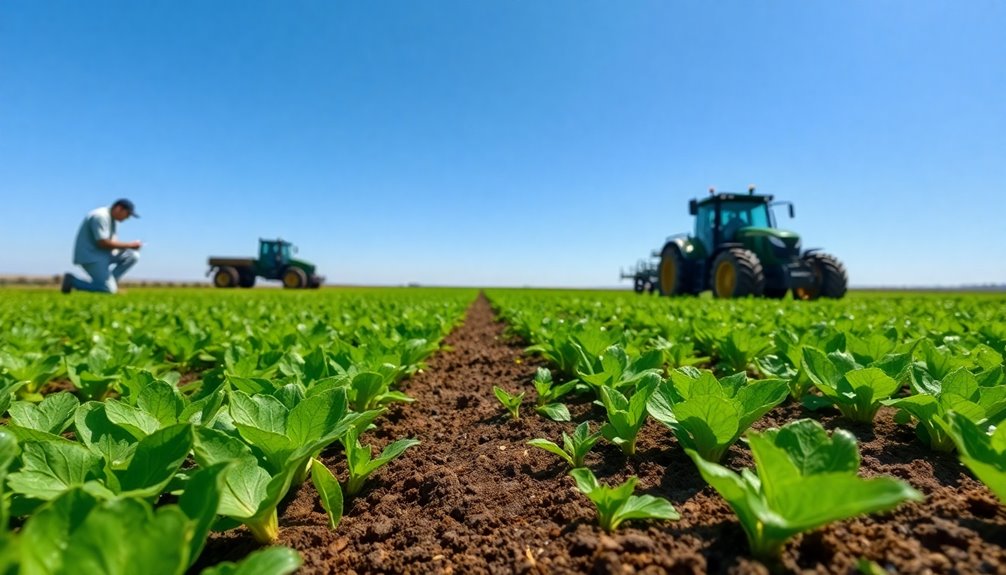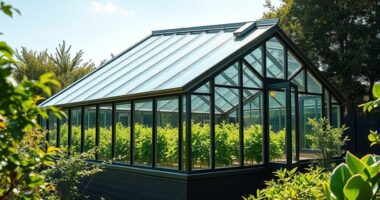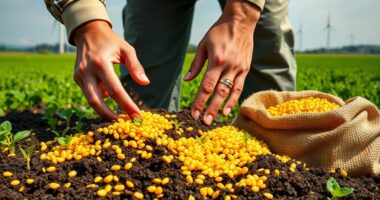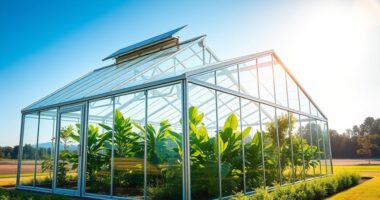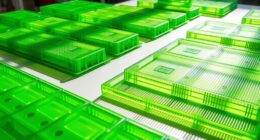Sustainable Intensification (SI) boosts your agricultural productivity while significantly cutting soil nitrate loss. By adopting techniques like crop rotation and precision agriculture, you can maintain steady yields and enhance environmental health. SI not only reduces nitrate runoff, but also improves soil health and promotes biodiversity. This holistic approach ensures economic viability and resilience against environmental challenges. There's a lot more to discover about how SI can transform farming for a sustainable future.
Key Takeaways
- Sustainable Intensification (SI) practices significantly reduce soil nitrate loss while maintaining stable crop yields.
- Techniques like crop rotation and integrated pest management effectively minimize nitrate runoff.
- SI promotes soil health through conservation agriculture and cover crops, preventing erosion and enhancing land management.
- Economic benefits arise from SI, improving farmer livelihoods while ensuring environmental stewardship.
- Adopting SI principles leads to resilient farming systems that address environmental challenges and support long-term sustainability.
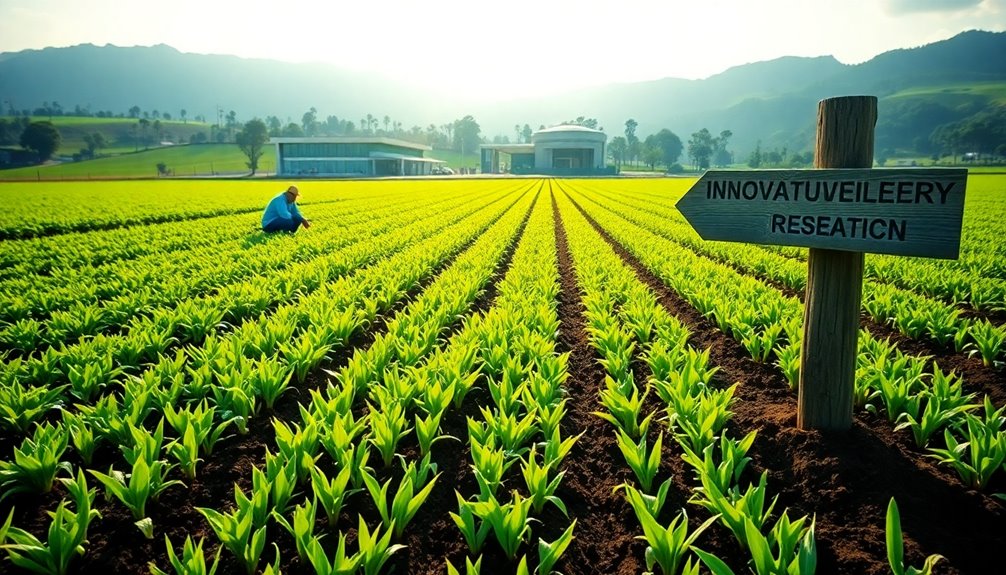
As you explore the concept of Sustainable Intensification (SI), you'll discover it's a powerful approach designed to boost agricultural productivity while minimizing environmental harm. SI focuses on enhancing resource efficiency and biodiversity, using innovations to increase yields on existing farmland without additional environmental costs.
It's about maintaining ecosystem services and building resilience against environmental stresses, all while ensuring social and economic sustainability.
Research shows that SI significantly cuts soil nitrate loss, which is critical for both environmental health and agricultural productivity. By implementing practices like crop rotation systems and integrated pest management, you can effectively maintain yields while reducing nitrate runoff. This not only improves water quality but also supports healthier ecosystems.
SI practices like crop rotation and integrated pest management significantly reduce soil nitrate loss, enhancing both yields and ecosystem health.
Moreover, agroecological practices promote biodiversity, enhancing the resilience of your farming systems. Biodiversity and ecosystem services should be maintained or improved, which is a crucial aspect of sustainable intensification.
You'll also find that SI encourages the use of cover crops and conservation agriculture, which are crucial for maintaining soil health. These practices minimize soil erosion and promote better land management, leading to sustainable farming.
Techniques like precision agriculture allow you to optimize resource use, ensuring that every input contributes to your yields without harming the environment. Minimum tillage or no-till methods keep soil disturbance to a minimum, further protecting soil integrity.
The benefits of SI extend beyond just environmental impacts; they also encompass social and economic aspects. By adopting SI practices, you can improve your income and livelihood as a farmer.
It's a holistic approach that recognizes the interconnectedness of agricultural productivity, environmental stewardship, and economic viability.
In a world facing increasing environmental challenges, Sustainable Intensification offers a viable path forward. By reducing soil nitrate loss and keeping yields steady, you're not just enhancing your farm's productivity; you're contributing to a sustainable future for agriculture.
Embracing SI principles can lead to a more resilient, productive, and environmentally friendly farming system.
Frequently Asked Questions
What Is Sustainable Intensification in Agriculture?
Sustainable intensification in agriculture means increasing productivity while minimizing environmental impact.
You focus on improving resource efficiency and protecting natural resources, which helps meet food security demands. By using methods like crop rotation and conservation agriculture, you boost soil health and biodiversity.
This approach not only enhances yields but also reduces reliance on chemicals, ultimately benefiting both farmers and the environment.
It's about cultivating a more resilient and productive agricultural system for everyone.
How Does Soil Nitrate Loss Impact the Environment?
Imagine a garden thriving under a sunny sky, only to be choked by unseen pollutants.
Soil nitrate loss can wreak havoc on the environment, polluting drinking water and harming aquatic ecosystems. It fuels algae blooms, suffocating fish and depleting oxygen.
Plus, it contributes to greenhouse gases, accelerating climate change. As nitrate lingers in the soil, it diminishes fertility, threatening future crops and human health, especially for vulnerable infants.
You can help change this.
What Crops Benefit Most From Sustainable Intensification?
You'll find that crops like corn and soybeans thrive under sustainable intensification, with corn showing significant yield improvements through mixed rotations.
Soybeans maintain yields while cutting nitrate losses.
Dual-purpose varieties of millet and cowpea also excel, offering both grain and fodder benefits.
Additionally, sorghum enhances both grain yields and biomass.
Are There Economic Benefits to Sustainable Intensification Practices?
Think of sustainable intensification as a golden key unlocking economic potential for farmers.
By adopting these practices, you're not just boosting crop yields; you're also increasing your profits and gaining access to premium markets.
With the support of government incentives, you'll find that these methods lower costs while enhancing productivity.
Ultimately, you're investing in a future where both your community and the environment thrive together, ensuring long-lasting benefits for everyone involved.
How Can Farmers Implement Sustainable Intensification Techniques?
You can implement sustainable intensification techniques by diversifying your crops and rotating them regularly. This reduces reliance on monocultures while enhancing soil health.
Adopt conservation agriculture practices to minimize soil disturbance and improve moisture retention. Utilize efficient irrigation systems to optimize water use and incorporate agroecological pest management to decrease chemical reliance.
Lastly, invest in training and technology to enhance your farming practices, ensuring a balance between productivity and environmental stewardship.
Conclusion
In a world where every drop of soil nutrients counts, embracing sustainable intensification isn't just smart—it's essential. By reducing soil nitrate loss while maintaining steady yields, you're not just farming; you're nurturing the future of our planet. Picture a landscape where productivity meets responsibility, ensuring that generations to come can thrive. So, let's cultivate a balance that feeds both people and the earth, proving that sustainable practices can lead us toward a greener tomorrow.
